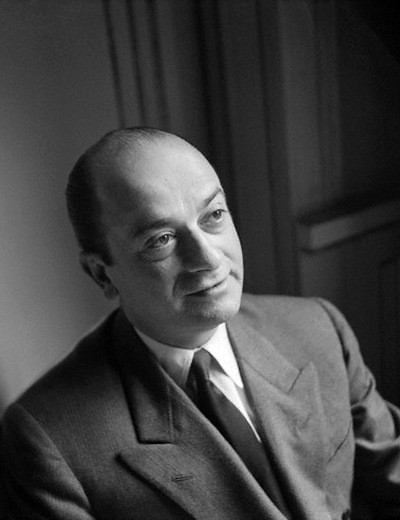
Jean Dimitre Verginie
About
Desses was born Jean Dimitre Verginie, in 1904, in Alexandria, Egypt, of Greek parents. In 1925, he abandoned his legal studies study law, but, in 1925, he abandoned his legal studies and began working for Maison Jane, a Parisian couture house where, in 1937, he opened his own couture salon.
After World War II, he traveled extensively in Egypt and Greece, and his designs in the 40's and 50's reflected the influences of his travels. He specialized in creating draped evening gowns in chiffon and mousseline, based on early Greek and Egyptian robes. He made embroidered dresses and sheath dresses with tight jackets and flowing skirts. He was a very popular designer with European royalty and movie stars. Among his clientele were the royal family ladies of Greece, the Duchess of Windsor and society hostess Elsa Maxwell.
His collections were hailed by the press as being very original. Time and again the showstoppers were his intricate flowing chiffon evening dresses. For these he used ombre fabrics, a favourite effect. His fur coats were shaded light to dark. He tried to dethrone the colour black, by use of soft hazy colours in dresses that involved much plaiting and twisting, as one or more fabrics were joined with ribbons or bands of mink. Often scarves trailed from neck to floor, and rippled, like his uneven hems.
In 1945, Desses participated in the fashion doll exhibition held in Paris called "Theatre de la Mode" held by the Chambre of Couture in the Louvre Museum. Approximately 172 dolls dressed by 40 couturiers were shown. This exhibition subsequently went on tour all over Europe and the USA.
In 1949 Desses began producing ready-to-wear lines for the US market.
Valentino worked with Desses for several years in the 1950s and gained much hands-on experience, as did Guy Laroche who in the 1950's was Desses' assistant.
In 1958, Desses move to 12 Rond Point des Champs Elysees in Paris. In 1963, when he reached 60 years of age, he was in poor health so he closed his business and retired to Greece, where he ran a boutique which he had opened there earlier, in 1955.
He died in 1970 at the age of 66.
In the 90's, with the surge of interest in vintage dresses, the gowns of Desses have been in great demand.
The Look
Jean Dessés belongs to the small group of couturiers, such as Vionnet, Balenciaga, and Grés, whose clothing combines technical skill with sculptural aesthetic. The hallmarks of his postwar fame are evident in his prewar work. Draped and twisted sashes and bodices, cape or kimono sleeves, a fondness for asymmetry, and ornament derived from the architecture of the garment rather than applied as surface decoration, were all elements of both his day and evening wear in the late 1930s. Dessés' transition from jersey to chiffon may have been mandated by the fuller silhouettes of the 1940s, or perhaps by the fact that Madame Grés was the acknowledged master of the draped jersey column, but the change set him on a path which made his name. By 1958 they were termed "classic." The variations on the theme seemed endless, but there are several important common factors. Appearances notwithstanding, the dresses were not always simple Grecian draperies. The understructures were formal and the cuts were complex, with swags, sashes, bows, and scarves twisted and pleated into shapes that seem effortless and defy analysis; in lesser hands they might simply seem contrived. The dresses also show his sensitive, if somewhat conservative, color sense. Cream or ivory, always flattering, are constants, but Dessés often used two or three shades of one hue, or used three different hues, but of equal value, to maintain harmony. It is also worth noting that the garments are impeccably made; every yard of hem in the double-or triple-tiered chiffon skirts has a hand-rolled finish. Dessés was equally deft with crisp silks, rough tweeds, and fine dress wools, and his most skilful and inventive draping and cutting techniques were often allied with these fabrics. Dropped shoulder lines, raglan or kimono sleeve variations, and draped collars softened voluminous mohair coats and tweed suit jackets. Tucks, godets, and intricate seaming molded crepe and gabardine dresses to the contours of the figure. Skirt fullness was swept to the back, folded in at the side, or turned into tiers of flounces which spiraled from hem to hip—all through manipulation of the grain in one piece of cloth. The most successful of his silhouettes, such as the Streamlined and Winged collections of 1949 and 1951, may not have set trends, but they interpreted the trend with elegance. He favored asymmetry and oblique lines, which gave the garments a sense of movement even in repose. Bold, architectural details such as stand-away pockets and cuffs were used like punctuation marks, adding drama and intensity to a silhouette. Dessés made complex but not fussy clothes, and, on occasion, did set the trend in 1950 when he introduced a onesleeved stole.
Who Wears It
Naomi Campbell, Princess Sophia of Greece, Renée Zellweger, Jennifer Lopez